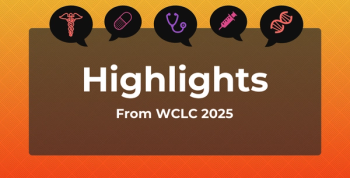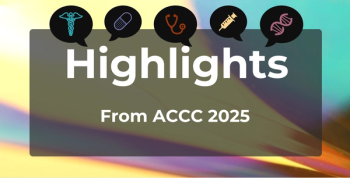
- August 2025
- Volume 31
- Issue Spec. No. 9
- Pages: SP592-SP593
Advances in Oncology: When Innovation and Challenge Intersect
Key Takeaways
- Precision oncology advancements have transformed cancer care, emphasizing biomarker-driven therapies and multidisciplinary collaboration to optimize patient outcomes.
- Lung cancer care has shifted from chemotherapy to personalized approaches, with biomarker analysis being crucial for effective treatment.
Precision oncology's promise was the key theme of the July 17 session of the Institute for Value-Based Medicine with faculty from multiple institutions in the Boston, Massachusetts area.
“Driving the Future of / Cancer Care,” an evening presented by the Institute for Value-Based Medicine and The American Journal of Managed Care, took place in Boston on July 17.
It brought together experts from Beth Israel Deaconess Medical Center, Boston Medical Center, Dana-Farber Cancer Institute, Lahey Health, Lowell General Hospital, Massachusetts General Hospital, and Tufts Medical Center.
Advances in precision oncology have transformed cancer care and reshaped treatment paradigms. During an evening of dialogue on value-based oncology at the Boston regional Institute for Value-Based Medicine, key intersecting themes in this space emerged: the critical role of biomarker-driven therapies, the challenges of implementing innovative treatments, and the necessity of multidisciplinary collaboration to optimize patient outcomes. The evening highlighted the delicate balance between innovation and implementation and emphasized the importance of collaborative care models in optimizing oncology’s evolving landscape.
Discussions focused on lung cancer and how the shift from chemotherapy to personalized approaches has improved outcomes, despite persistent barriers that include tissue acquisition and insurance coverage for next-generation sequencing (NGS). Experts said there is debate over how long patients should receive immunotherapy and how to rechallenge patients with therapy. Similarly, in hematologic malignancies, bispecific antibodies and chimeric antigen receptor (CAR) T-cell therapies demonstrate remarkable efficacy but pose logistical and toxicity management challenges. Breast cancer has seen progress, too, with antibody-drug conjugates (ADCs), which show superiority over traditional regimens in HER2-positive and HER2-low disease, but adjuvant CDK4/6 inhibitors face adherence and reimbursement hurdles, especially in community practices.
Central to these advancements is the expanding role of pharmacy in value-based care, particularly in managing complex therapies like CAR T and bispecifics. Pharmacists contribute to toxicity management, care transitions, and real-world data utilization, yet site-of-care restrictions and payer mandates complicate delivery.
Lung Cancer Care Requires Biomarker Analyses
Over the past 2 decades, there has been significant improvement in lung cancer care, with treatment shifting from platinum-based chemotherapy to precision medicine and immunotherapy. “Today, we will not move ahead with any treatment for non–small cell lung cancer (NSCLC) without biomarker analysis,” stated Karl D’Silva, MD, a medical oncologist with Lahey Health, whose practice is now approximately 30% thoracic medicine. He was joined by Umit Tapan, MD, thoracic oncologist, Boston Medical Center; and Julia Rotow, MD, clinical director, Lowe Center for Thoracic Oncology, Dana-Farber Cancer Institute, who moderated the discussion, “Value-Driven Precision: Advancing Equitable Access to Targeted and Immuno-Oncology Therapies in Lung Cancer.”
Key advancements include the identification of EGFR and its role in lung cancer development1 and how ALK mutations can direct treatment choice and response,2 followed by immunotherapy approvals, with nivolumab (Opdivo; Bristol Myers Squibb) being the first in 2015,3 which have extended survival from 6 to 9 months to 3 to 5 years for many patients, Tapan explained.
However, significant implementation challenges remain, including delays in accessing tissue; slow turnaround times, particularly for second-opinion referrals and identifying candidates for targeted therapies or immunotherapy; and insurance hurdles for inpatient diagnoses that call for NGS. “Inpatients are the sickest patients at diagnosis, who have the greatest need for rapid results,” Rotow noted, “and yet they face the most significant barriers to rapid results.”
“Understanding a patient’s biomarker profile on the tumor itself is critical to offering effective first-line therapy, and that means we need to know that biomarker as soon as possible,” she explained in an interview with The American Journal of Managed Care. “Without these data, we can always give patients chemotherapy, but then we’re really denying them all the advances of the last 15 years in the field.”
The panelists debated optimal timing for immunotherapy in early-stage NSCLC—neoadjuvant vs adjuvant—underscoring that multidisciplinary collaboration is key, with some centers favoring neoadjuvant chemoimmunotherapy and others reserving adjuvant therapy for surgically upstaged patients. They also discussed whether shorter courses of immunotherapy could be both effective and less toxic to patients. Some clinicians treating patients with metastatic cancer stop therapy at 2 years, while others persist indefinitely. This draws mixed reactions from patients, with some happy to complete therapy but others fearful of recurrence.
The panelists concurred that advocacy for evidence-based insurance appeals, policy changes, and payer education is critical, as precision medicine directly impacts quality of life and survival. This is essential not only in academic medical centers but also in community and rural practices, where the ability to interpret complex results may be more limited. Many questions remain, with variability in practice reflecting unresolved evidence.
Strategies for Optimizing CAR T and Bispecifics
Andrew Yee, MD, clinical director, Center for Multiple Myeloma, Massachusetts General Hospital, prompted the start of the evening’s second panel discussion, “Optimizing Care Models for CAR T and Bispecifics: Addressing Cost, Infrastructure, and Access Challenges,” by asking fellow panelist Amir Fathi, MD, director of the leukemia program at Mass General, to describe the therapies’ use in the myeloid and/or leukemia space.
Focusing on blinatumomab (Blincyto; Amgen), a CD-19 bispecific T-cell engager,4 Fathi explained that close to 50% of patients with acute lymphoblastic leukemia (ALL) receive the agent and that current evidence shows it to be especially effective and well tolerated in patients with a low disease burden. This is a high-risk disease, he noted, so many patients with it “will not clear their disease in terms of minimal residual disease.” However, the therapy requires administration via a 4-week continuous infusion, and community practices sometimes need follow-up, creating inconvenience for patients. Subcutaneous community administration is being studied, with clinical trials showing promising results, but this formulation is neither approved nor available.
Andreas Klein, MD, interim chief, Division of Hematology Oncology, and director, Bone Marrow + Stem Cell Transplant and Cellular Therapies, Tufts Medical Center, continued the discussion, focusing on bispecifics in lymphomas. He did not pull any punches, stating that although these therapeutics are not curative, they are easier to administer than first thought. Toxicity is manageable through step-up dosing to mitigate the severity of cytokine release syndrome, he said. They also have shown promise in treating diffuse large B-cell (DLBCL) and follicular lymphomas. “It’s sort of doing the most, doing the best, for the patient with the least amount of adverse effects, knowing that you’re going to come back and do something else, and something else,” Klein said. He also highlighted barriers related to CAR T programs, such as contracting and arranging for reimbursement, including the costs beyond therapy itself. Until now, manufacturer-mandated safety protocols have been burdensome, but there is hope on the horizon with the recent removal of the FDA Risk Evaluation and Mitigation Strategies requirements.5 Tufts has also been able to piggyback on its bone marrow transplant program by leveraging existing staff and systems.
Using this as a jumping-off point, David Nguyen, MD, medical oncologist/hematologist, Lowell General Hospital/Tufts Medical Center, and the lone community oncologist on the panel, spoke about the instances when he must refer patients from the community to academic centers. There are many hurdles, he noted, especially for patients with early relapsed DLBCL in whom CAR T has largely replaced autologous transplants. These include insurance approvals, travel requirements, and communication system differences. He continued that strong academic-community partnerships are vital in these instances, and they don’t lose many patients to follow-up, with community-academic partnerships that facilitate patient monitoring.
The panel discussed when to use CAR T vs bispecifics, highlighting the pros and cons of each treatment. CAR T may confer high response rates and longer durability, with most requiring only 1 dose—after previous treatment failure or bridging chemotherapy6—but the infrastructure needs are significant. Bispecifics have lower response rates and require “chronicity of delivery” after more lines of therapy—a minimum of 4 vs the possibility of receiving CAR T after 1 (ciltacabtagene autoleucel; Carvykti; Johnson & Johnson7) or 2 prior lines (idecabtagene vicleucel; Abecma; Bristol Myers Squibb/2seventy bio8)—but they have the advantage of off-the-shelf access, Yee explained.
Addressing Unmet Needs in Breast Cancer
A discussion on breast cancer, “Evolving Breast Cancer Care: Addressing Unmet Needs Across the Patient Journey,” came next, with experts from Dana-Farber and Lowell General Hospital/Tufts exploring key advancements and ongoing challenges in the space, including the rapid pace of change in oncology overall. Moderator Adrienne Waks, MD, associate director, breast oncology clinical research, Dana-Farber, was joined by Michael Hassett, MD, MPH, chief quality officer; and Leticia Varella, MD, senior physician in medical oncology, both from Dana-Farber, as well as Anasuya Gunturi, MD, PhD, medical director of the cancer center and chief of hematology/oncology, Lowell General Hospital/Tufts. The group focused on how novel therapies are reshaping treatment and underscored the real-world challenges that persist across care settings—all while emphasizing the need to bridge clinical progress with personalized and equitable care delivery.
Highlighting findings from the DESTINY-Breast09 (NCT04784715) and DESTINY-Breast06 trials (NCT04494425), Varella spoke about the growing role of ADCs, especially trastuzumab deruxtecan (T-DXd), in HER2-positive and HER2-low metastatic breast cancer.9,10 Results from both trials, she explained, support the therapy’s use in earlier lines of treatment, even as questions remain on optimal patient selection, and treatment-related toxicity and costs.
“Are we going to offer T-DXd to patients in the first line,” Varella asked, “or can we, for example, offer capecitabine to some of the patients? It’s a much cheaper drug, a very well-tolerated oral. These are the things we all have to consider in clinical practice.”
The panel stressed the importance of reassessing pathology reports, especially for patients diagnosed with HER2-low disease, because this can help identify patients eligible for ADCs. Gunturi spoke about recent discussions with the pathology lab at Lowell, noting the need to check more carefully for HER2 status. “Looking back at those pathology reports where we, in our notes, have just claimed a patient to be HER2-negative, I now have to go back and look and see—were they actually zero, or were they 1+, 2+, and now ultra low?”
Panelists also deliberated administration of adjuvant CDK4/6 inhibitors, including the expanded use of ribociclib following a 2024 FDA approval11 as an example of how new options can make decision-making more complex.
Hassett emphasized the urgent need for better biomarkers, calling current HER2-low definitions “sort of made up” and insufficient to guide therapy. “To me, some of the real interesting future directions are, can we develop better biomarkers that identify response to these novel HER2-directed therapies—and not have to use older approaches around secondary analysis of immunochemistry testing—to really try to fine-tune that population that’s going to benefit from the treatment?”
Their conversation shifted to the logistical and financial barriers patients typically face when initiating oral therapies, and how these play out in the setting of treatment adherence. Waks described the “heavy lift” as something that typically has a negative impact on patient well-being, encompassing not only lab monitoring but also navigating insurance delays and those financial implications. Even in early-stage settings, the panel noted that out-of-pocket costs can influence the decision to abandon treatment.
In closing, the panel highlighted the need for tailored education all around and more structured and empathetic approaches to education and adverse effect management. They urged clinicians to examine potential biases in judging which patients can best handle aggressive treatment and to use patient-reported outcomes data to normalize expectations; this can improve treatment adherence. The panelists emphasized that innovation must be matched with infrastructure, insight, and inclusive care models that meet patients where they are.
Collaborating With Pharmacy
Pharmacists are increasingly central to optimizing value in oncology care due to the increased complexity of some treatments and the shift of care delivery beyond hospitals. In “Collaborating With Your Pharmacist to Optimize Value in Oncology,” clinical pharmacy experts shared how they support high-quality, cost-effective cancer treatment—from implementing advanced therapies to navigating payer restrictions and expanding access. Moderator Corey McEwen, PharmD, MS, director, oncology pharmacy services, Mass General, was joined by Jessica Freydman, PharmD, BCOP, clinical pharmacist-leukemia; and Matthew Lei, PharmD, BCOP, oncology clinical pharmacist, both also of Mass General, and Lelas Shamaileh, PharmD, BCOP, clinical pharmacist specialist-hematology/oncology, Beth Israel Deaconess Medical Center (BIDMC).
Their conversation began with examples of how pharmacy teams help operationalize therapies like bispecifics and CAR T. Freydman described managing blinatumomab’s transition from inpatient to outpatient, which involves coordinating computerized ambulatory drug delivery, or CADD, pump logistics, and follow-up. “The final boss of leukemia is getting a Friday admission for a Sunday discharge on blinatumomab,” she said, underscoring the complexity pharmacists routinely manage. At present, blinatumomab is indicated to treat minimal residual disease: positive B-cell precursor ALL and relapsed/refractory B-cell precursor ALL.12
In multiple myeloma care, Lei explained that pharmacy touches everything from billing to supportive care and called for embedding durable, retrievable resources into electronic medical records so that any provider can make informed decisions.
“It’s great for a provider to put something in their notes, but when you have to dig after 6 months or so for supportive care resources,” he posed, “how do you have enduring resources that are really retrievable to every single member of the care team?”
At BIDMC, Shamaileh shared how pharmacy has helped establish criteria for delivering CAR T outside the hospital, taking especially careful consideration with things like proximity to care, housing during treatment, and comorbidities—anything that may predispose these patients to a higher risk of complications, even preparing emergency departments for complications to safely decentralize care.
“It’s just a lot of making sure that everybody on board knows about the toxicity management and feels comfortable with something that’s so nuanced,” she explained.
By expanding therapies to community sites, pharmacy teams also enable broader access, which eases capacity burdens and brings care closer to home, with pharmacy developing guidelines and training to ensure consistency, McEwen noted. However, payer-imposed site-of-care mandates are creating new challenges. Instead of letting providers decide where care occurs, payers often dictate administration sites, and he noted that inadequate infrastructure for outpatient infusion makes this especially hard, not only on the treatment front but regarding revenue, too.
“I would say we’re losing out on at least tens of millions of dollars of revenue of just all of those drugs that we’re no longer being able to buy and bill for,” he said, citing the burdens of white bagging and outside pharmacy coordination.
Despite these pressures, the panelists saw potential in reducing inpatient costs—if decisions stay clinically driven. Real-world evidence emerged as a key tool for guiding both clinical and financial decisions.
The discussion closed with a call for continued collaboration. Pharmacists are vital to integrating new therapies, from developing education materials to identifying patients who can be safely treated in the community.
“I think pharmacy can work really close with the hematologists and oncologists to create models where we share the workload,” Freydman said. “Pharmacies are set up to manage a lot of care and do a lot of dosing and conduct a lot of visits. And if that model can be applied in different disease states, I think there’s a lot of potential there to work really closely and share practice.”
References
1. Rosell R, Moran T, Queralt, et al; Spanish Lung Cancer Group. Screening for epidermal growth factor receptor mutations in lung cancer. N Engl J Med. 2009;361(10):958-967. doi:10.1056/NEJMoa0904554
2. Shaw AT, Engelman JA. ALK in lung cancer: past, present, and future. J Clin Oncol. 2013;31(8):1105-1111. doi:10.1200/JCO.2012.44.5353
3. NCI staff. FDA approves first immunotherapy treatment for lung cancer. News release. National Cancer Institute. March 24, 2015. Accessed July 27, 2025. https://www.cancer.gov/news-events/cancer-currents-blog/2015/fda-opdivo
4. Burt R, Warcel D, Fielding AK. Blinatumomab, a bispecific B-cell and T-cell engaging antibody, in the treatment of B-cell malignancies. Hum Vaccin Immunother. 2019;15(3):594-602. doi:10.1080/21645515.2018.1540828
5, McCormick B. FDA expands access to approved CAR T-cell therapies by eliminating REMS. AJMC®. June 30, 2025. Accessed July 28, 2025. https://www.ajmc.com/view/fda-expands-access-to-approved-car-t-cell-therapies-by-eliminating-rems
6. DeMarco C. Need CAR T cell therapy? Here’s what to expect. MD Anderson Cancer Center. January 20, 2023. Accessed July 28, 2025. https://www.mdanderson.org/cancerwise/need-car-t-cell-therapy--here-is-what-to-expect-what-happens-during-car-t-cell-therapy.h00-159615489.html
7. Shaw M. FDA approves cilta-cel for earlier treatment of RRMM. AJMC. April 6, 2024. Accessed July 28, 2025. https://www.ajmc.com/view/fda-approves-cilta-cel-for-earlier-treatment-of-rrmm
8. Bonavitacola J. Ide-cel receives approval for earlier treatment for relapsed, refractory multiple myeloma. AJMC. April 5, 2024. Accessed July 28, 2025. https://www.ajmc.com/view/ide-cel-receives-approval-for-earlier-treatment-for-relapsed-refractory-multiple-myeloma
9. Trastuzumab deruxtecan (T-DXd) with or without pertuzumab versus taxane, trastuzumab and pertuzumab in HER2-positive metastatic breast cancer (DESTINY-Breast09). Clinicaltrials.gov. Updated May 6, 2025. Accessed July 29, 2025. https://clinicaltrials.gov/study/NCT04784715
10. Study of trastuzumab deruxtecan (T-DXd) vs investigator’s choice chemotherapy in HER2-low, hormone receptor positive, metastatic breast cancer (DB-06). Clinicaltrials.gov. Updated June 18, 2025. Accessed July 29, 2025. https://clinicaltrials.gov/study/NCT04494425
11. Santoro C. FDA approves ribociclib for early breast cancer treatment with high recurrence rate. AJMC. September 17, 2024. Accessed July 29, 2025. https://www.ajmc.com/view/fda-approves-ribociclib-for-early-breast-cancer-treatment-with-high-recurrence-rate
12. Blincyto (blinatumomab). Prescribing information. Amgen; 2018. Accessed July 30, 2025. https://www.accessdata.fda.gov/drugsatfda_docs/label/2018/125557s013lbl.pdf
Articles in this issue
Newsletter
Stay ahead of policy, cost, and value—subscribe to AJMC for expert insights at the intersection of clinical care and health economics.







































